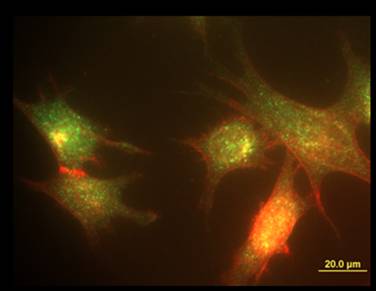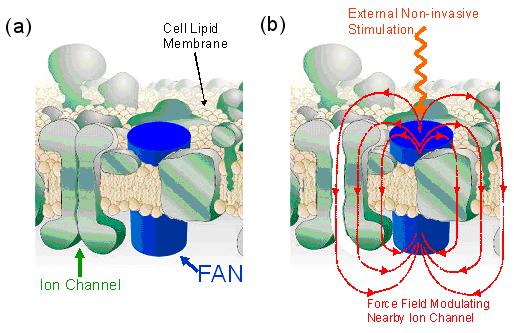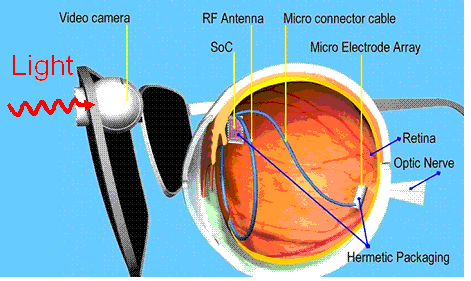|
Biophysics,
Bioengineering, and Nanomedicine
I.
Real-Time Live-Cell Imaging of Intracellular Processes
II.
Functional Abiotic Nanosystems for Intracelluar Prostheses
Real-Time
Live-Cell Imaging of Intracellular Processes

The ability to examine intracellular
structure and processes in live cells is fundamental to understanding
phenomena underlying diseases and pathways for intervention.
To address issues of clinical importance (chosen in conjunction
with colleagues in the USC Keck School of Medicine) we are
embarked upon studies utilizing optical microscopy, spectroscopy,
and imaging of live cells. To find out more, please click
on the categories below or click
here to read our paper.
I. Epifluorescent
and Confocal Microscopy
II. Near-Field Optical
Microscopy
III. Real-Time
Imaging of Cells Under Stress
Functional
Abiotic Nanosystems for Intracellular Prostheses
The Concept of Functional Abiotic
Nanosystem (FAN):
To examine intracellular
processes and to create intracellular prostheses, we have
introducted the concept of Functional
Abiotic Nanosystems (FAN). FAN's are nanoscale systems
that perform an active function
and consist of appropriately
engineered composites of nanoscale building blocks such as
organic/biochemical (but abiotic) nanoparticles or inorganic
nanocrystals (such as quantum dots, quantum rods, etc.). The
FAN's provide higher level functions beyond, for example,
the current simple uses of individual quantum dots as imaging
labels or local heaters. An implementation of the FAN
concept is the modulation of transmembrane potential of neuronal
cells through its strategic placement near ion channels. This
is shown schematically in figure 1 where the FAN is activated
to provide change in local electric field. The active function
is to induce channel opening upon external stimulation (e.g.
via photon). In this way, a FAN acts as a nanoscale intracellular
prosthesis.

Fig. 1: Schematic showing strategic placement of FAN near
ion channel protein to induce gate opening upon external stimulation.
The first application
of FAN being investigated is potentially restoring vision
for individuals with blindness due to the loss of photoreceptors
in an otherwise intact retina. To learn how we propose to
achieve this, please read on.
Functional Abiotic Nanosystem (FAN)
as a Nanoscale Photodiode for Retinal Prosthesis
"This non-invasive electrical
stimulation using embedded FAN may offer a variety of oppotunities
ranging from probing fundamental intracellular electric processes
to endowing/restoring light sensitivity to retinal neurons
(such as the retinal ganglion cells) and serving as nanoscale
devices for visual prosthesis." [1] A FAN as a cellular-prosthesis
for retinal stimulation is shown schematically
in figure 2. FANs designed to act as nanoscale photodiodes
are to be embedded directly in the plasma membrane of retinal
ganglion cells (RGCs). Upon light excitation, the induced
photovoltage created by the FAN's may be tailored to modulate
the transmembrane potential sufficiently to open nearby ion
channels. Such opening can trigger action potential which
travel down the optic nerve to the visual cortex and lead
to sensation of vision.
The idea of stimulating retinal ganglion
cells in patients blind due to loss of photoreceptors is being
actively pursured by a number of groups including a
team of researchers at USC (BMES),
including us. However, all such efforts use microelectronics
based macroscopic implants (Fig. 3) much like the cochlear
implants used to restore hearing in the deaf. Employing engineered
photovoltaic FAN's embedded directly in the retinal ganglion
cells, as we are embarked upon, would obviate the need for
such macroscopic implants, requiring only an injection of
FAN's into the eye. A major advantage of our approach is its
minimally invasive nature.

Fig.2 Nanoscience based paradigm to restore vision: Direct
stimulation of retinal ganglion cells using trans-membrane
embedded photosensitive Functional Abiotic Nanosystem (FAN).

Fig.3 Current paradigm to restore vision: stimulate
ganglion cells using implanted macroscopic electrodes.
See our paper
for more details
S. Lu and A. Madhukar, "Cellular prostheses:
functional abiotic nanosystems to proble, manipulate, and
endow functions in live cells." Nanomedicine: Nanotechnoloty,
Biology, and Medicine, 6, 409-418 (2010) [CLICK
HERE]
References:
[1] Siyuan Lu, Ph.D. Dissertation, chapter 7, pp 337, University
of Southern California, 2006.
|